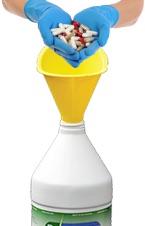|
A. Damaged, expired, unwanted, unusable, or unreturnable controlled substances and dangerous
drugs must be accounted for, stored, and disposed of in accordance with applicable
state and federal regulations.
B. Disposal of a controlled substance or dangerous drug must render it “non-retrievable”.
The DEA states that “’non-retrievable’ shall permanently alter the substance’s physical
or chemical condition or state through irreversible means and thereby render the substance
unavailable and unusable for all practical purposes.”
C. Disposal by flushing down the sink or mixing into kitty litter DOES NOT meet DEA or Ohio Board
of Pharmacy standards for rendering controlled substances or dangerous drugs non-retrievable.
D. There are three disposal options for expired or unwanted controlled substances or
dangerous drugs. Two employees of the registrant must handle or observe the handling
of any controlled substance or dangerous drug until it is transferred or rendered
non-retrievable.
-
- On-site Disposal: Small quantities of controlled substances and dangerous drugs can be disposed onsite by
the DEA registrant or authorized agent using the following procedure:
a. Complete the Registrant Record of Controlled Substances Destroyed (DEA Form 41)
prior to controlled substance disposal (see section E below).
b. Complete a University of Toledo Dangerous Drug Disposal Log prior to dangerous drug disposal.
c. controlled substance or dangerous drug must be rendered non-retrievable by permanently
altering the substance’s physical or chemical condition or state through irreversible
means and thereby rendering the substance unavailable and unusable for all practical
purposes. The only approved methods for irreversible destruction and waste are the
use of either Drug Buster® or RX Destroyer®. These can be purchased through Medline
(Drug Buster®) or Health Care Logistics (RX Destroyer ®).
d. Once the Drug Buster® or RX Destroyer® containers are completely full, the Department of
Environmental Health and Radiation Services will dispose of them.
- Reverse Distribution: For large quantities or volumes of controlled substances or dangerous drugs, contact a
reverse distributor. This option transfers ownership of the controlled substance to
a DEA-approved pharmaceutical returns processor for re-use, re-sale, or destruction
at a hazardous waste incinerator. This process may involve the completion of DEA Form
222 or DEA Form 41 depending on the reverse distributor and the substances involved.
Contact for reverse distributors may be obtained from the IACUC Office.
- Contact the Supplier: Some suppliers will take back unopened controlled substances or dangerous drugs for credit.
This process may involve the completion of manufacturer-specific return or recall
transaction records or DEA Form 222 depending on the supplier and the substances involved.
E. Registrant Record of Controlled Substances Destroyed (DEA Form 41) must be completed prior to disposing of any controlled substance and a copy must
be retained by the registrant or authorized agent.
F. Registrants and authorized agents must maintain disposal records with the following
information:
-
- The registrant's DEA number, name, and address, if applicable.
- If a reverse distribution is done, the reverse distributor's DEA number, name and
address.
- The number of units (in finished forms and/or commercial containers) disposed of in
any manner, including the manner of disposal.
- The date when the products were sent for destruction and left the registrant's or
authorized agent's inventory.
- Any additional documentation recording the exchange of custody.
|



